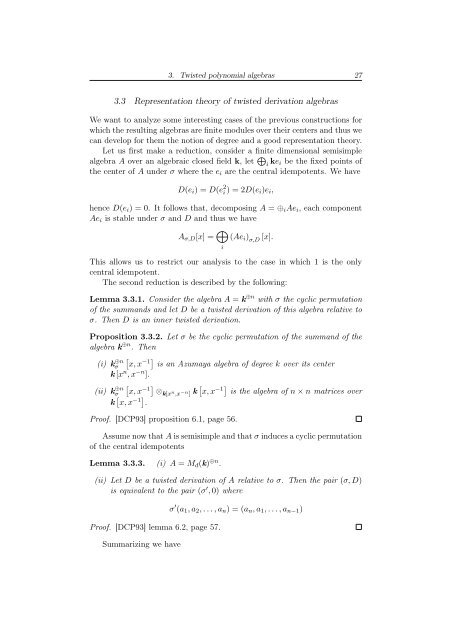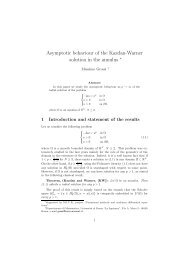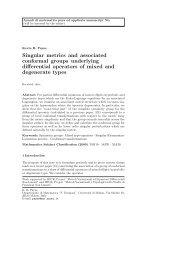Degree of Parabolic Quantum Groups - Dipartimento di Matematica ...
Degree of Parabolic Quantum Groups - Dipartimento di Matematica ...
Degree of Parabolic Quantum Groups - Dipartimento di Matematica ...
You also want an ePaper? Increase the reach of your titles
YUMPU automatically turns print PDFs into web optimized ePapers that Google loves.
3. Twisted polynomial algebras 27<br />
3.3 Representation theory <strong>of</strong> twisted derivation algebras<br />
We want to analyze some interesting cases <strong>of</strong> the previous constructions for<br />
which the resulting algebras are finite modules over their centers and thus we<br />
can develop for them the notion <strong>of</strong> degree and a good representation theory.<br />
Let us first make a reduction, consider a finite <strong>di</strong>mensional semisimple<br />
algebra A over an algebraic closed field k, let <br />
i kei be the fixed points <strong>of</strong><br />
the center <strong>of</strong> A under σ where the ei are the central idempotents. We have<br />
D(ei) = D(e 2 i ) = 2D(ei)ei,<br />
hence D(ei) = 0. It follows that, decomposing A = ⊕iAei, each component<br />
Aei is stable under σ and D and thus we have<br />
Aσ,D[x] = <br />
(Aei) σ,D [x].<br />
i<br />
This allows us to restrict our analysis to the case in which 1 is the only<br />
central idempotent.<br />
The second reduction is described by the following:<br />
Lemma 3.3.1. Consider the algebra A = k ⊕n with σ the cyclic permutation<br />
<strong>of</strong> the summands and let D be a twisted derivation <strong>of</strong> this algebra relative to<br />
σ. Then D is an inner twisted derivation.<br />
Proposition 3.3.2. Let σ be the cyclic permutation <strong>of</strong> the summand <strong>of</strong> the<br />
algebra k ⊕n . Then<br />
(i) k ⊕n<br />
<br />
σ x, x−1 is an Azumaya algebra <strong>of</strong> degree k over its center<br />
k [xn , x−n ].<br />
(ii) k ⊕n<br />
<br />
σ x, x−1 ⊗k[xn ,x−n ] k x, x−1 is the algebra <strong>of</strong> n × n matrices over<br />
k x, x−1 .<br />
Pro<strong>of</strong>. [DCP93] proposition 6.1, page 56.<br />
Assume now that A is semisimple and that σ induces a cyclic permutation<br />
<strong>of</strong> the central idempotents<br />
Lemma 3.3.3. (i) A = Md(k) ⊕n .<br />
(ii) Let D be a twisted derivation <strong>of</strong> A relative to σ. Then the pair (σ, D)<br />
is equivalent to the pair (σ ′ , 0) where<br />
Pro<strong>of</strong>. [DCP93] lemma 6.2, page 57.<br />
Summarizing we have<br />
σ ′ (a1, a2, . . .,an) = (an, a1, . . .,an−1)








